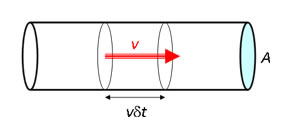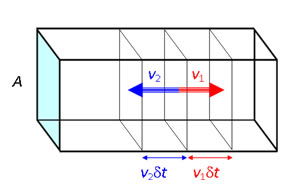Electric current
Level 0 (green)- this is basic material that you have probably encountered already, although the approach may be slightly different. No prior knowledge is assumed.
Electric current is the flow of electrical charge, the current is defined is the rate at which charge flows past a point, or through a dividing surface, per unit time
![]()
The SI units of electric current are A (Ampere), which are equivalent to C s–1. The A is the SI base electrical unit, so 1 C is the same as 1 A s.
Because electrons have negative charge, by convention, the direction of electric current is opposite to the direction of flow of electrons.
We are most familiar with electric current in the form of the flow of electrons through a wire, so we envisage charged particles drifting with a constant velocity v through the wire.
If the charge on each carrier is q, the density of charge carriers per unit volume is n, and the cross-sectional area of the wire is A, the number of charge carriers drifting past a point in time δt is the number of charge carriers in volume Avδt, i.e. nAvδt. |
 |
Drift velocities in a conducting wire are typically very slow.
For example, consider a copper wire. The maximum current a wire of cross sectional area 1 mm2 can carry is 4 A. Assuming that each atom releases one conduction electron, and given the density of copper, 8960 kg m–3, the number density of conduction electrons per unit volume in the copper is 8.5×1028 m–3. We deduce that the drift velocity at this maximum current density is about 3×10–4 m s–1.
In fact the kinetic energy of a typical conduction electron in Cu is several eV, which implies a typical speed of the order of 1.6×106 m s–1, thus the drift velocity of an electron, which gives rise to the electric current is about 10 orders of magnitude smaller than the random motions of the electrons in the metal. This is analogous to the familiar concept of fluid flow. The rate of flow of water or of air is much smaller than the typical speeds of the particles.
The same ideas can be applied to electric current carried by ions drifting through solution. In general there will be more than one type of current carrier, drifting through the solution with different charges and different speeds.
If the charge on species i is qi, and the density of these charge carriers per unit volume is ni, and the cross-sectional area of the cell is A, the current must take into account the possibility that different charge carriers may drift at different rates, and that oppositely charged ions may drift in different directions. |
 |
The problem of the current in an ion beam is less well defined than the examples above. This is because the number of ions per unit volume may not be well defined. Instead the current must be calculated from the number of ions per unit time in the beam, or the number of ions per unit length in the beam. The formula for current has to be worked out separately for each individual system.
For example if an linear accelerator has a beam current of 1 mA then the beam must contain (on average) i/q = 6.24×1015 electrons per second.